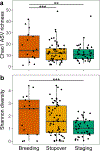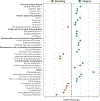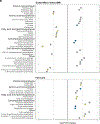Convergent remodelling of the gut microbiome is associated with host energetic condition over long-distance migration
- PMID: 38249446
- PMCID: PMC10795773
- DOI: 10.1111/1365-2435.14430
Convergent remodelling of the gut microbiome is associated with host energetic condition over long-distance migration
Abstract
The gut microbiome can be thought of as a virtual organ given its immense metabolic capacity and profound effects on host physiology. Migratory birds are capable of adaptively modulating many aspects of their physiology to facilitate long-distance movements, raising the hypothesis that their microbiome may undergo a parallel remodeling process that helps to meet the energetic demands of migration.To test this hypothesis, we investigated changes in gut microbiome composition and function over the fall migration of the Blackpoll Warbler (Setophaga striata), which exhibits one of the longest known autumnal migratory routes of any songbird and rapidly undergoes extensive physiological remodeling during migration.Overall, our results showed that the Blackpoll Warbler microbiome differed significantly across phases of fall migration. This pattern was driven by a dramatic increase in the relative abundance of Proteobacteria, and more specifically a single 16S rRNA gene amplicon sequence variant belonging to the family Enterobacteriaceae. Further, Blackpoll Warblers exhibited a progressive reduction in microbiome diversity and within-group variance over migration, indicating convergence of microbiome composition among individuals during long-distance migration. Metagenomic analysis revealed that the gut microbiome of staging individuals was enriched in bacterial pathways involved in vitamin, amino acid, and fatty acid biosynthesis, as well as carbohydrate metabolism, and that these pathways were in turn positively associated with host body mass and subcutaneous fat deposits.Together, these results provide evidence that the gut microbiome of migratory birds may undergo adaptive remodeling to meet the physiological and energetic demands of long-distance migration.
Keywords: 16S rRNA; Blackpoll Warbler; birds; gut microbiome; metagenomics; migration; passerine; physiology.
Conflict of interest statement
CONFLICT OF INTEREST The authors have no conflicts of interest to declare.
Figures







Similar articles
-
Long-duration wind tunnel flights reveal exponential declines in protein catabolism over time in short- and long-distance migratory warblers.Proc Natl Acad Sci U S A. 2023 Apr 25;120(17):e2216016120. doi: 10.1073/pnas.2216016120. Epub 2023 Apr 17. Proc Natl Acad Sci U S A. 2023. PMID: 37068245 Free PMC article.
-
Migratory blackpoll warblers (Setophaga striata) make regional-scale movements that are not oriented toward their migratory goal during fall.Mov Ecol. 2017 Jul 3;5:15. doi: 10.1186/s40462-017-0106-0. eCollection 2017. Mov Ecol. 2017. PMID: 28680638 Free PMC article.
-
Transoceanic migration by a 12 g songbird.Biol Lett. 2015 Apr;11(4):20141045. doi: 10.1098/rsbl.2014.1045. Biol Lett. 2015. PMID: 25832815 Free PMC article.
-
Covariation of the Fecal Microbiome with Diet in Nonpasserine Birds.mSphere. 2021 May 12;6(3):e00308-21. doi: 10.1128/mSphere.00308-21. mSphere. 2021. PMID: 33980682 Free PMC article.
-
Gut microbiome of migratory shorebirds: Current status and future perspectives.Ecol Evol. 2021 Apr 3;11(9):3737-3745. doi: 10.1002/ece3.7390. eCollection 2021 May. Ecol Evol. 2021. PMID: 33976772 Free PMC article. Review.
Cited by
-
Uropygial gland microbiota of nearctic-neotropical migrants vary with season and migration distance.Anim Microbiome. 2025 Jan 30;7(1):11. doi: 10.1186/s42523-024-00367-8. Anim Microbiome. 2025. PMID: 39885562 Free PMC article.
-
Phylogenetic and ecological drivers of the avian lung mycobiome and its potentially pathogenic component.Commun Biol. 2025 Apr 19;8(1):634. doi: 10.1038/s42003-025-08041-8. Commun Biol. 2025. PMID: 40253508 Free PMC article.
-
Stopover habitat selection drives variation in the gut microbiome composition and pathogen acquisition by migrating shorebirds.FEMS Microbiol Ecol. 2024 Apr 10;100(5):fiae040. doi: 10.1093/femsec/fiae040. FEMS Microbiol Ecol. 2024. PMID: 38515294 Free PMC article.
References
-
- Alerstam T, Hedenström A, & Åkesson S (2003). Long-distance migration: Evolution and determinants. Oikos, 103(2), 247–260. 10.1034/j.1600-0706.2003.12559.x - DOI
-
- Balk L, Hägerroth P-Å, Åkerman G, Hanson M, Tjärnlund U, Hansson T, Hallgrimsson GT, Zebühr Y, Broman D, Mörner T, & Sundberg H (2009). Wild birds of declining European species are dying from a thiamine deficiency syndrome. Proceedings of the National Academy of Sciences, 106(29), 12001–12006. 10.1073/pnas.0902903106 - DOI - PMC - PubMed
Grants and funding
LinkOut - more resources
Full Text Sources
